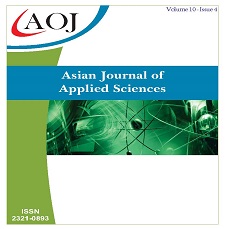Non Linear Dielectric Phenomenon in BaTiO3 - Bi (Ti1-xMgx)O3 . Ceramic Material
DOI:
https://doi.org/10.24203/ajas.v10i4.7036Keywords:
non linear dielectric, tunability, permittivityAbstract
The distinguishing characteristic of an insulator is its resistivity. An insulator has a higher resistivity than a semiconductor or conductor and has high dielectric properties. The adjustable dielectric property is characterized by a change in the permittivity of the dielectric under an applied electric field, this phenomenon is called "dielectric nonlinearity" (dielectric tunability properties). With these properties, a new phenomenon will arise adjustable dielectric properties in dielectric ceramic materials. The aim of this research is to observe the non-linear dielectric phenomenon in BaTiO3-Bi(Ti1-xMgx)O3 ceramic material with x= 0.5, 0.6, 0.7, 0.8 and 0.9. Ceramic materials were synthesized using the sol-gel method which produced nano-sized powders. Impedance data was measured using an impedance analyzer (Solartron SI 1260, Solartron Metrology, West Sussex, UK) in a frequency range of 100 Hz to 500 Hz with an ac measuring voltage of 0.1 V. Dielectric tunability properties were measured from 0oC to 250oC using an automatic component analyzer. at 10 kHz. All samples show the phenomenon of dielectric tunability with different maximum permittivity. The highest permittivity was obtained at x= 0.6 but the highest transition temperature where non-linear phenomena occurred was found in the sample with x= 0.5.
References
. Dwita S, Yuli Nurul M, “Enhancing the electrical properties of multiferroic materials based on variations in BiFeO3 – BaTiO3 weight ratio”, Journal of Ceramic Processing Research, 22(1), 2021.
. Dwita S, Yuli Nurul M, Marlin W, “Improving of electric voltage response based on improving of electrical properties for multiferroic material of BiFeO3 – BaTiO3 system”, Key Engineering Materials, 867, 2020.
. Dwita S, Yuli Nurul M, Marlin W, “Improving magnetic properties of BiFeO3 – BaFe12O19 solid solutions by different sintering time and temperatures of sol – gel method”, Asian Journal of Applied Sciences, 7(5), 2019.
. Tagantsev A.K, Sherman V.O, Astafiev K.F, Venkatesh J, Setter N, “Ferroelectric materials for microwave tunable applications”, J. Electroceram, 11, 2003.
. Kong L.B, Li S, Zhang T.S, Zhai J.W, Boey F.Y.C, Ma J, “Electrical tunable dielectric materials and strategies to improve their performances”, Prog. Mater.Sci, 55, 2010
. Wei X.Y, Yao X, “Reversible dielectric nonlinearity and mechanism of electrical tunability for ferroelectric ceramics”, Int. J. Mod. Phys, 20, 2006.
. Feng Y.J, Xu Z, Wei X.Y, Yao X, “Dielectric behaviour of antiferroelectric lead zirconate titanate under strong electric field”, Acta. Phys. Sinica, 52, 2003.
. Wang J.F, Yang T.Q, Wei K, Li G, Chen S.C, “Tunable dielectric constant of antiferroelectric PZT ceramics under DC electric field”, J.Am. Ceram.Soc, 95, 2012
. Uchida, N, Ikeda T, “Temperature and bias characteristics of Pb(Zr-Ti)O3 families ceramics”, Jpn, J. Appl. Phys, 4, 1965.
. Drougard M.E, Young D.R, “Domain clamping effect in barium titanate single crystals”, Phys. Rev, 94, 1954
. Zhang Q, Li Z.R, Li F, Xu Z, “Structural and dielectric properties of Bi(Mg1/2Ti1/2)O3-BaTiO3 lead free ceramics”, J.Am, Ceram.Soc, 94, 2013.
. Xiong B, Hao H, Zhang S.J, Liu H.X, Cao M.H, “Stucture, dielectric properties and temperature stability of BaTiO3-Bi(Mg1/2Ti1/2)O3 perovskite solid solutions”, J.Am.Ceram. Soc, 94, 2011.
Satoshi W, Keisuke Y, Petr P, Nobuhiro K, Bong-Yeon L, Takashi I, Chikako M, Yoshihiro K, “Piezoelectric properties of high curie temperature barium titanate bismuth perovskite type oxide system ceramic”, J. Appl. Phys, 108, 2010.
. Doo H.C, Amanda B, Michael L, Susan T.M, Clive R, “Structural and dielectric properties in (1-x)BaTiO3-xBi(Mg1/2Ti1/2)O3 ceramics (0.1≤ x ≤ 0.5) and potential for high voltage multilayer capacitors”, J.Am.Ceram.Soc, 96, 2013.
. Pengron R, Xin W, Huiqing F, Yang R, Gaoyang Z, “Structure, relaxation, behaviors and nonlinear dielectric properties BaTiO3-bi(Ti0.5Mg0.5)O3 ceramics”, Ceramic International, Elsevier, 2015
Downloads
Published
Issue
Section
License
Copyright (c) 2022 Dwita Suastiyanti, Pathya Rupajati, Marlin Wijaya

This work is licensed under a Creative Commons Attribution-NonCommercial 4.0 International License.
- Papers must be submitted on the understanding that they have not been published elsewhere (except in the form of an abstract or as part of a published lecture, review, or thesis) and are not currently under consideration by another journal published by any other publisher.
- It is also the authors responsibility to ensure that the articles emanating from a particular source are submitted with the necessary approval.
- The authors warrant that the paper is original and that he/she is the author of the paper, except for material that is clearly identified as to its original source, with permission notices from the copyright owners where required.
- The authors ensure that all the references carefully and they are accurate in the text as well as in the list of references (and vice versa).
- Authors retain copyright and grant the journal right of first publication with the work simultaneously licensed under a Attribution-NonCommercial 4.0 International that allows others to share the work with an acknowledgement of the work's authorship and initial publication in this journal.
- Authors are able to enter into separate, additional contractual arrangements for the non-exclusive distribution of the journal's published version of the work (e.g., post it to an institutional repository or publish it in a book), with an acknowledgement of its initial publication in this journal.
- Authors are permitted and encouraged to post their work online (e.g., in institutional repositories or on their website) prior to and during the submission process, as it can lead to productive exchanges, as well as earlier and greater citation of published work (See The Effect of Open Access).
- The journal/publisher is not responsible for subsequent uses of the work. It is the author's responsibility to bring an infringement action if so desired by the author.


